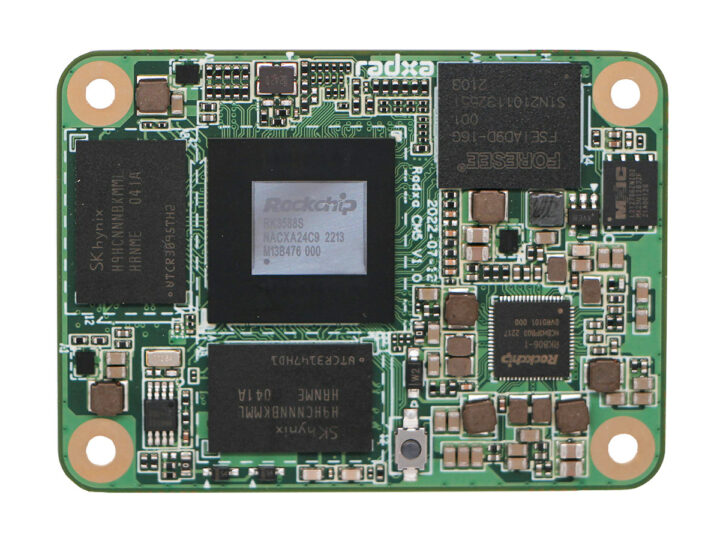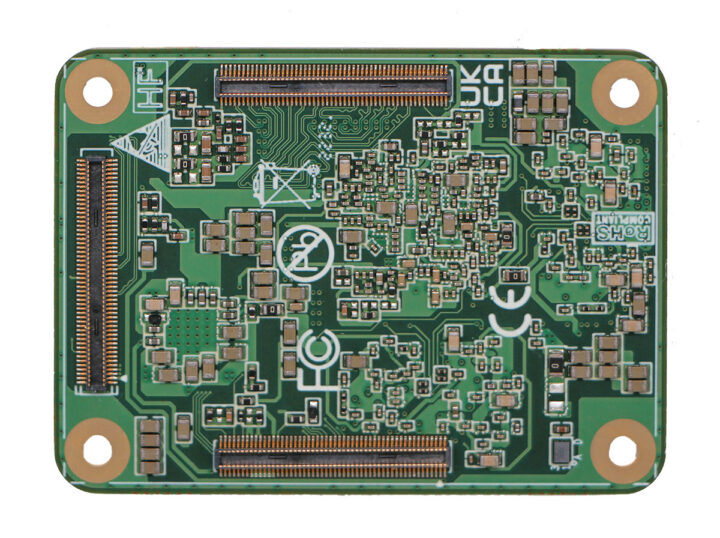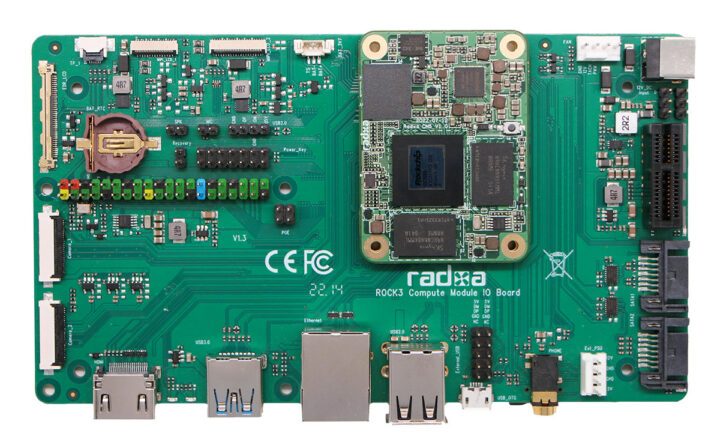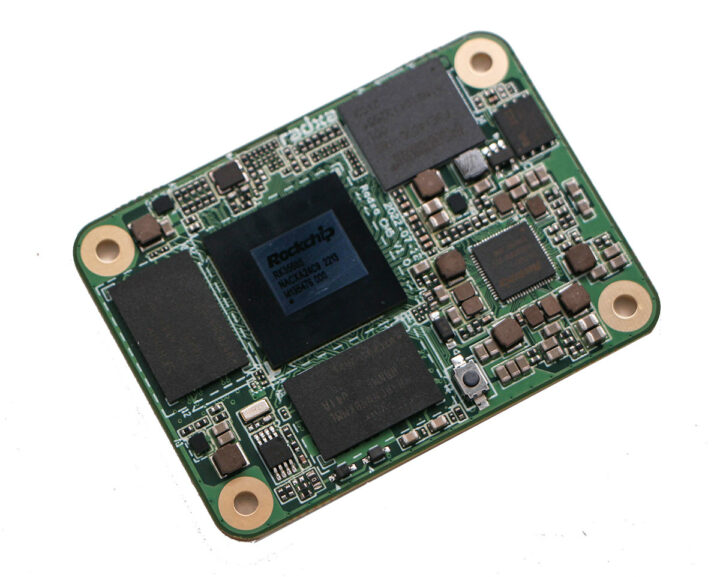Radxa has been working on the ROCK 5 Compute Module (aka Radxa CM5) system-on-module compatible with Raspberry Pi CM4, but based on the more powerful Rockchip RK3588S octa-core Cortex-A76/A55 SoC.
Just like the Raspberry Pi Compute Module 4, it comes in a 55 x 40mm form factor, but instead of just two high-density 100-pin board-to-board connectors, the module includes three to cater for the additional I/Os from the Rockchip processor, just like they did for the Radxa CM3 equipped with a Rockchip RK3566 processor.
Radxa CM5 specifications:
- SoC – Rockchip RK3588S octa-core processor with
- System Memory – 4GB, 8GB, or 16GB LPDDR4x4224 SDRAM
- Storage – Optional 8GB, 16GB, 32GB, 64GB, or 128GB eMMC flash memory up to 250MB/s
- 3x 100-pin 0.4mm pitch board-to-board connectors
- Storage
- 2x SATA interfaces, one shared with USB 3.0, the other with PCIe
- SD card suppor via SDIO interface
- Video Interfaces
- 1x HDMI 2.1 up to 8K60
- 2x 4lane MIPI DSI interfaces (MIPI DSI0, MIPI DSI1)
- 1x eDP up to 8K60 (shared with HDMI)
- Camera I/F
- 2-lane MIPI CSI camera interface
- 4lane MIPI CSI camera interface
- Networking – Gigabit Ethernet (No PHY on module)
- USB – 1x USB 2.0, 1x USB 3.1 port (5Gbps), 1x USB 3.0 host port
- PCIe – 2x PCIe 1lane host, Gen 2.1 (5Gbps)
- Other peripherals
- 1x SDIO 3.0
- Up to 50x GPIO supporting either 1.8V or 3.3V
- Up to 8x UART, 8x I2C, 4x SPI
- 1x PCM
- Up to 8x PWM channels
- 2x ADC
- Storage
- Supply Voltage – Single +5V DC input
- Dimensions – 55 x 40 x 3mm (PCB)

 Radxa CM5 is designed to help people requiring custom carrier boards. It supports the same operating systems as the Rockchip RK3588-powered ROCK 5B single board computer including Ubuntu 20.04, Debian 11, and Android 12, plus Buildroot and the Yocto Project build system are also available.
Radxa CM5 is designed to help people requiring custom carrier boards. It supports the same operating systems as the Rockchip RK3588-powered ROCK 5B single board computer including Ubuntu 20.04, Debian 11, and Android 12, plus Buildroot and the Yocto Project build system are also available.
The SoM can be used for Robotics, HMI, vending machines, Smart Home devices, IoT gateways, industrial controllers, medical equipment (TBC), and so on. It’s compatible with the ROCK3 Compute Module IO board, and should work on most carrier boards designed for the Raspberry Pi Compute Module 4 as well, although there are caveats, as we’ll discuss below.

There will be exceptions, as some of the interfaces, such as the second HDMI interface, are missing, and the module is too small / the processor too big, to have enough space for a wireless module, so it would have implemented on the carrier board, or using a USB dongle. The module also lacks the Gigabit Ethernet PHY (such as RTL8211F) found on RPi CM4 and Radxa CM4, so I don’t see how Ethernet can work on existing carrier boards as well. Sadly, that means backward compatibility is limited and only works if you don’t need networking.
Raspberry Pi CM4 | Radxa CM3 | Radxa CM5 |
|
|---|---|---|---|
| SoC | Broadcom BCM2711 quad-core Cortex-A72 processor @ 1.5 GHz with VideoCore VI GPU | Rockchip RK3566 quad-core Cortex-A55 processor @ 2.0 GHz with Arm Mali-G52 2EE GPU, 0.8 TOPS AI accelerator | Rockchip RK3588S octa-core Cortex-A76/A55 processor @ 2.4 GHz / 1.8 GHz with Arm Mali-G610 MP4 GPU, 6 TOPS AI accelerator |
| System Memory | 1GB, 2GB, 4GB or 8GB LPDDR4-3200 SDRAM | 4GB, 8GB or 16GB LPDDR4x-4224 SDRAM |
|
| Storage | None, 8GB, 16GB, 32GB, 64GB, 128GB eMMC Flash memory up to 100MB/s SDIO 2.0 for CM4Lite only | None, 8GB, 16GB, 32GB, 64GB, 128GB eMMC Flash memory up to 250MB/s SDIO 3.0 |
|
| Display interfaces | 2x HDMI up to 4Kp60 1x 2-lane MIPI DSI display interface 1x 4-lane MIPI DSI display interface | 1x HDMI up to 4K60 2x 4-lane MIPI DSI display interfaces 1x 4-lane LVDS multiplexed with 1x MIPI DSI 1x eDP up to 4Kp60 | 1x HDMI up to 8Kp60 2x 4-lane MIPI DSI display interfaces 1x eDP up to 8K60 |
| Camera interfaces | 1x 2-lane MIPI CSI camera port 1x 4-lane MIPI CSI camera port |
||
| Audio codec | No (must be on carrier board) | Yes | No (must be on carrier board) |
| Ethernet | Gigabit Ethernet PHY with IEEE 1588 support | Gigabit Ethernet PHY (RTL8211F) with optional IEEE 1588 support | Gigabit Ethernet (No PHY) |
| Wireless | Optional Wi-Fi 5 & Bluetooth 5.0 | N/A |
|
| USB | 1x USB 2.0 | 1x USB 2.0, 1x USB 3.0 (5 Gbps) | 1x USB 2.0, 1x USB C 3.1 port (5Gbps), 1x USB 3.0 host port |
| PCIe | 1× 1-lane PCIe Gen 2 (5Gbps) | 2× 1-lane PCIe Gen 2.1 (5Gbps) |
|
| SATA | N/A | 2x SATA multiplexed with PCIe and USB 3.0 interfaces |
|
| GPIO | 28x GPIO Up to 5x UART Up to 5x I2C Up to 5x SPI 1x SDIO interface 1x DPI (Parallel RGB Display) 1x PCM 2x PWM channels Up to 3x GPCLK outputs 1.8V and 3.3V support | 50x GPIO: Up to 8 × UART Up to 8 × I2C Up to 4 × SPI 1x SDIO interface 1x PCM Up to 8x PWM 2x ADC 1.8V and 3.3V support |
|
| Board-to-board connectors | 2x 100-pin B2B connectors | 3x 100-pin B2B connectors |
|
| Supply Voltage | Single 5V input voltage |
||
| DImensions | 55 x 40 mm |
||
Besides working on a Rockchip RK3588S module with the Raspberry Pi CM4 form factor, the company is also prepping the Radxa NX5 SO-DIMM module that offers compatibility with NVIDIA Jetson Nano, TX2 NX, and Xavier NX system-on-modules. We’ll cover that one once we have more details.
Radxa guarantees the availability of the Radxa CM5 until at least September 2032, or a 10-year long-term supply commitment. We don’t have pricing information just yet, but I’d expect the Radxa CM5 to cost a bit more than the Radxa CM3 or Raspberry Pi CM4. A few additional details may be found on the wiki.

Jean-Luc started CNX Software in 2010 as a part-time endeavor, before quitting his job as a software engineering manager, and starting to write daily news, and reviews full time later in 2011.
Support CNX Software! Donate via cryptocurrencies, become a Patron on Patreon, or purchase goods on Amazon or Aliexpress





